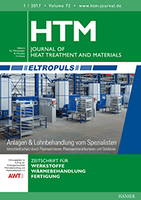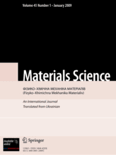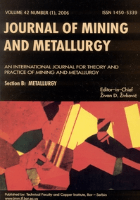
HTM-Journal of Heat Treatment and Materials
Scope & Guideline
Connecting academia and industry through cutting-edge research.
Introduction
Aims and Scopes
- Heat Treatment Technologies:
The journal emphasizes various heat treatment processes, including quenching, tempering, nitriding, and surface hardening techniques, exploring their effects on material properties and performance. - Materials Science and Engineering:
A core focus on the relationship between materials' microstructural characteristics and their mechanical properties, particularly in the context of heat treatment, is prevalent in the journal's publications. - Innovative Applications and Developments:
The HTM Journal showcases advancements in heat treatment technologies and materials applications, including novel alloys, coatings, and surface treatments that enhance performance in various industrial sectors. - Computational Methods and Modeling:
Research in computational modeling and simulation of heat treatment processes is highlighted, providing insights into process optimization and predictive modeling of material behaviors. - Sustainability and Efficiency:
An increasing emphasis on sustainable practices and energy efficiency in heat treatment processes, reflecting the industry's shift towards more environmentally friendly technologies. - Tribological and Mechanical Properties:
Investigation into the tribological behavior and mechanical properties of materials post-heat treatment, including studies on wear resistance, fatigue life, and corrosion resistance.
Trending and Emerging
- Integration of Artificial Intelligence and Machine Learning:
Recent publications indicate a growing interest in the application of AI and machine learning techniques to optimize heat treatment processes, predict material properties, and enhance quality control. - Advanced Surface Treatments and Coatings:
There is an increasing focus on novel surface treatment technologies, including plasma nitriding, laser hardening, and advanced coatings, aimed at improving wear resistance and corrosion protection. - Sustainable Practices in Heat Treatment:
Research highlighting sustainable methods in heat treatment, such as CO2-neutral processes and energy-efficient technologies, is on the rise, reflecting the industry's commitment to reducing environmental impact. - Additive Manufacturing and Heat Treatment Synergy:
Emerging studies explore the intersection of additive manufacturing and heat treatment, investigating how heat treatment can enhance the properties of additively manufactured components. - Microstructural Characterization Techniques:
Advancements in techniques for characterizing microstructures post-heat treatment, including non-destructive testing and advanced microscopy methods, are increasingly featured, enhancing understanding of material behaviors.
Declining or Waning
- Traditional Heat Treatment Methods:
There has been a noticeable decrease in publications focusing solely on conventional heat treatment methods, such as basic quenching and tempering, as research shifts towards more advanced and innovative techniques. - General Material Properties without Heat Treatment Context:
Research that discusses material properties in a general sense, without a specific focus on heat treatment applications, has become less frequent, indicating a move towards more specialized studies. - Non-Technical Reports and Updates:
The frequency of publications that serve as non-technical updates or general announcements has declined, suggesting a preference for more substantive research articles over informational content. - Basic Theoretical Studies:
There is a waning interest in purely theoretical studies that do not incorporate practical applications or experimental validation, as the journal increasingly favors applied research with tangible outcomes.
Similar Journals

Metallurgical Research & Technology
Connecting researchers to propel metallurgical advancements.Metallurgical Research & Technology is a distinguished journal published by EDP SCIENCES S A based in France, focusing on the dynamic field of metallurgical science and engineering. With a strong emphasis on the latest advancements in Materials Chemistry, Computational Mechanics, and Mechanics of Materials, this journal aims to provide a platform for researchers to share innovative findings that propel the field forward. As of 2023, it has secured a commendable position in various categories, including Q3 rankings in Computational Mechanics, Materials Chemistry, and Mechanics of Materials, along with a Q2 ranking in Metals and Alloys. The journal actively promotes open access, facilitating broader dissemination of critical research across the globe. Researchers, professionals, and students in the metallurgical domain will find Metallurgical Research & Technology an invaluable resource for cutting-edge developments and collaborative opportunities.

KOVOVE MATERIALY-METALLIC MATERIALS
Fostering Breakthroughs in Metallic ResearchKOVOVE MATERIALY-METALLIC MATERIALS, published by REDAKCIA KOVOVE MATERIALY, is a prominent journal embedded within the field of materials science, focusing particularly on metallic materials. With a history dating back to 1968, this Slovakian journal has made significant contributions to the understanding of materials chemistry, mechanical engineering, and the mechanics of materials. While currently classified in the Q4 category for Materials Chemistry and Mechanical Engineering, and Q3 for Metals and Alloys, it aims to provide a platform for high-quality research and novel findings in these domains. Furthermore, the journal is indexed within Scopus, reflecting its engagement with the global scientific community and its role in disseminating pivotal studies. Researchers, professionals, and students will find crucial insights and developments in the field, making it a valuable resource for those seeking to enhance their understanding of metallic materials and their applications.

METALS AND MATERIALS INTERNATIONAL
Elevating global discourse in materials innovation.METALS AND MATERIALS INTERNATIONAL, published by the Korean Institute of Metals and Materials, is a prestigious journal dedicated to the advancement of research in the fields of materials science and engineering. With an ISSN of 1598-9623 and a robust e-ISSN of 2005-4149, this journal has established itself as a crucial platform for disseminating innovative findings and key advancements that span condensed matter physics, materials chemistry, mechanics of materials, and the technology of metals and alloys. Its Q1 rankings in multiple categories attest to its high impact and relevance in the academic community, placing it among the top journals in its fields with Scopus rankings that reflect a strong international footprint. Here, researchers, professionals, and students can access cutting-edge research and insights, fostering collaboration and exploration of new materials and their applications. With a commitment to excellence and a convergence of knowledge from 1996 to 2024, METALS AND MATERIALS INTERNATIONAL continues to enhance our understanding of materials and their transformative impact on technology and engineering.

METALURGIJA
Exploring the depths of metallurgy with global collaboration.METALURGIJA is a distinguished open-access journal published by the Croatian Metallurgical Society, dedicated to advancing the field of metallurgical sciences and engineering. With an ISSN of 0543-5846 and E-ISSN of 1334-2576, this journal has been serving the academic community since its inception, offering valuable insights into condensed matter physics, materials chemistry, mechanics of materials, and metals and alloys. As of 2023, it ranks in Q3 in the fields of condensed matter physics, materials chemistry, and mechanics of materials, and Q2 in metals and alloys, reflecting its engagement with contemporary research and emerging trends. The journal's open-access policy, in place since 2002, ensures that high-quality research is accessible to a global audience, fostering collaboration and knowledge sharing. Located in Zagreb, Croatia, METALURGIJA aims to bring together researchers, industry professionals, and students alike to contribute to systemic advancements in metallurgical research and applications, ultimately enhancing innovation within the materials science community.

ACTA METALLURGICA SINICA
Leading the Charge in Mechanical and Geotechnical EngineeringACTA METALLURGICA SINICA, established in 1978 and published by SCIENCE PRESS, stands as a preeminent journal in the fields of metallurgy and materials science. This journal is particularly revered for its contributions to Metals and Alloys, Mechanical Engineering, Geotechnical Engineering, and Mechanics of Materials, with a commendable Q1 ranking in Metals and Alloys and notable placements in other engineering disciplines. With a robust history of facilitating scholarly communication from 1978 to 1991 and consistently since 1996, the journal provides a vital platform for researchers and practitioners to disseminate significant advancements in material science. Despite being a subscription-based journal, ACTA METALLURGICA SINICA remains pivotal, holding a Scopus ranking that places it in the top tiers of its categories, fostering an environment ripe for innovation and collaboration. This ensures that the journal remains central to the ongoing discussions and developments within the metallurgy community, serving both academic and professional interests.

CIS Iron and Steel Review
Pioneering Research in Metals and AlloysCIS Iron and Steel Review is a prestigious academic journal published by ORE & METALS PUBLISHERS, specializing in the fields of Industrial and Manufacturing Engineering and Metals and Alloys. With a strong commitment to advancing knowledge in these critical areas, the journal has achieved a significant position, evidenced by its Q2 category rankings in both fields for 2023 and an impressive Scopus ranking alongside a substantial global readership. Operating from the heart of the Russian Federation, it provides a platform for researchers, professionals, and students to share innovative breakthroughs, explore trends, and discuss challenges within the iron and steel industry. The journal supports open access formats, enabling wider accessibility and dissemination of research findings, thereby fostering collaboration and engagement within the scientific community. With its converged years spanning from 2014 to 2024, the CIS Iron and Steel Review remains pivotal in enhancing the understanding of materials science and engineering practices in an ever-evolving industrial landscape.

MATERIALS SCIENCE
Innovating Insights in Engineering and Physics.MATERIALS SCIENCE, a prominent journal published by SPRINGER, serves as a vital resource for researchers, professionals, and students in the fields of materials science, mechanical engineering, and condensed matter physics. With its ISSN 1068-820X and E-ISSN 1573-885X, this journal has been dedicated to sharing innovative research since its inception in 1993, and it continues to publish groundbreaking findings through 2024. Although it operates as a traditional subscription-based journal, its ranking in the Q3 quartile across multiple scientific categories, including Condensed Matter Physics, Materials Science, Mechanical Engineering, and Mechanics of Materials, signifies its relevance and impact in the academic community. Notably, its Scopus classifications reveal a competitive standing among its peers, ranking within the 25th to 33rd percentiles across various engineering and physics disciplines. The journal remains a key platform for disseminating valuable insights, fostering collaboration, and advancing the understanding of materials science.

Journal of Mining and Metallurgy Section B-Metallurgy
Elevating academic discourse in metallurgy and geotechnical engineering.Journal of Mining and Metallurgy Section B-Metallurgy is a prominent open-access journal published by the Technical Faculty, Bor-Serbia. Established in 2002, the journal has become a vital platform for disseminating high-quality research in the fields of metallurgy, geotechnical engineering, and materials sciences. With an E-ISSN of 2217-7175, the journal has successfully converged its publication years from 2007 to 2024, indicating its commitment to ongoing academic discourse. The journal is currently ranked Q3 in multiple categories including Geotechnical Engineering and Engineering Geology, Materials Chemistry, Mechanics of Materials, and Metals and Alloys, reflecting its importance in academic research and professional practice. With a Scopus rank that positions it within the 30th percentile across various related disciplines, the Journal of Mining and Metallurgy Section B-Metallurgy serves as an invaluable resource for researchers, professionals, and students who seek to explore cutting-edge advancements in metallurgy and materials science. It provides vital insights that contribute to the development and innovation in these essential fields.

Korean Journal of Metals and Materials
Empowering Scientific Discovery in Metals and MaterialsWelcome to the Korean Journal of Metals and Materials, a premier publication dedicated to advancing research in the interdisciplinary fields of metals and materials science. Published by the Korean Institute of Metals and Materials, this journal aims to foster the dissemination of innovative findings and significant developments across various domains, including electronic, optical, and magnetic materials, metals and alloys, as well as modeling, simulation, and surface coatings. With a commendable Q3 quartile ranking in several relevant categories as of 2023, it serves as a vital resource for researchers, professionals, and students interested in the latest scientific trends and technological applications. The journal has successfully converged from 2007 to 2024, showcasing a rich archive of knowledge. Engaging with this publication gives readers the opportunity to stay updated with critical advancements and enhances collaboration within the vibrant materials science community. Access is available through various platforms, ensuring that our content is widely accessible to all those striving for excellence in the field.

Materiali in Tehnologije
Unveiling Cutting-edge Discoveries in Materials ScienceMateriali in Tehnologije is a distinguished peer-reviewed journal dedicated to the field of materials science, focusing specifically on metals and polymers. Published by the Institute for Metals and Materials Technology in Slovenia, this open-access journal has been at the forefront of disseminating research findings and innovative technologies since 2000. With a current impact factor that reflects its increasing visibility in the academic community, Materiali in Tehnologije serves as an invaluable resource for researchers, professionals, and students alike, encompassing a wide array of studies in the categories of Metals and Alloys, as well as Polymers and Plastics. The journal is indexed in Scopus, highlighting its relevance and contribution to the field, particularly with its ranks of Q3 in Metals and Alloys and Q4 in Polymers and Plastics. As it converges towards 2024, Materiali in Tehnologije continues to be a pivotal platform for knowledge exchange, encouraging advancements in materials research and technology.